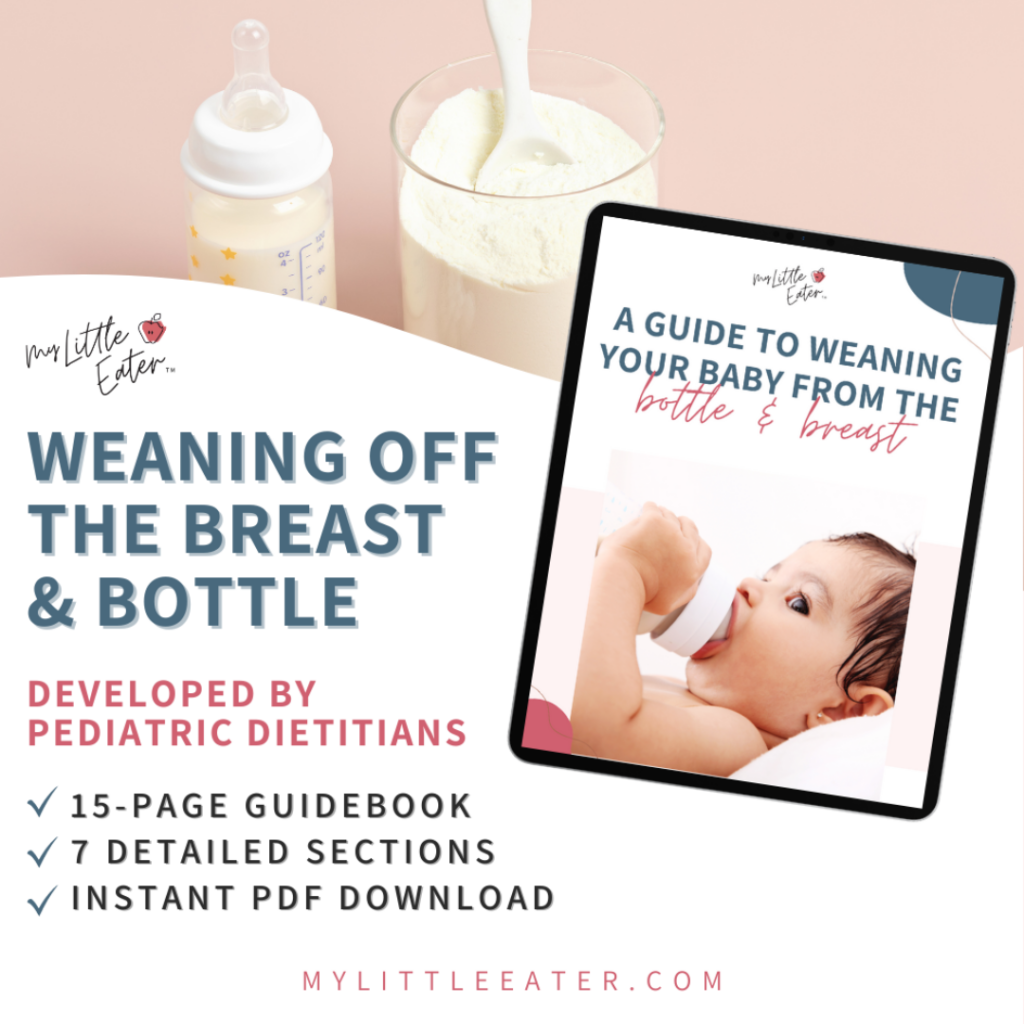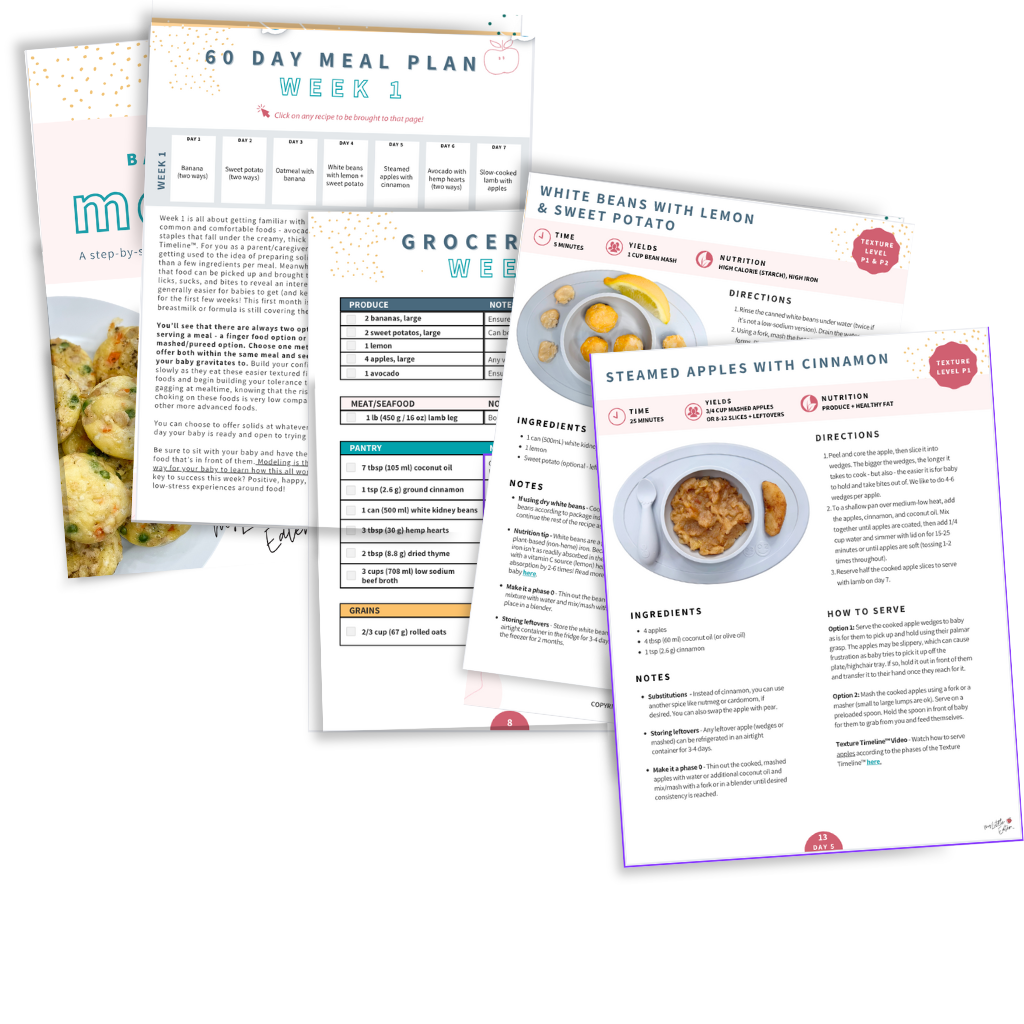This post may contain affiliate links, see our disclosure policy for details.
As your baby approaches their first birthday and you’re ready to wean them off of breast milk or formula, naturally, you may be wondering if whole milk is the best choice for your little one.
We know there are a lot of different opinions out there!
Some say it’s essential for growth, while others raise concerns about its fat content. With all the mixed messages, it’s normal to feel confused and even a bit worried – we get it!
In this blog, we’re going to provide clear, trustworthy information on whole milk for your baby – cutting through the noise and helping you make an informed choice. Whether you’re questioning if whole milk is the right fit or you just want to better understand how it impacts your child’s health, we’ve got the answers you need.
Let’s dive into the facts, so you can feel confident in your decision as your baby grows.

If you’re getting ready to start solids with your little one, you’re likely wondering how solid foods will impact your baby’s milk feeds.
Don’t worry – you won’t be fully weaning yet, it’s more of a gradual process!
But it can be a tricky transition and that’s why we created our breast and bottle weaning guide so you can feel prepared to enter this next stage of babyhood!

If you’re getting ready to start solids with your little one, you’re likely wondering how solid foods will impact your baby’s milk feeds.
Don’t worry – you won’t be fully weaning yet, it’s more of a gradual process!
But it can be a tricky transition and that’s why we created our breast and bottle weaning guide so you can feel prepared to enter this next stage of babyhood!

Table of Contents
When can babies drink milk?
Babies can start drinking cow’s milk (or another milk alternative if needed) when they turn 1 year of age.
Before your baby turns 1 year old, you’ll want to avoid offering any milk other than breastmilk or formula as a beverage. This includes any animal milk (like cow’s or goat’s milk) and any plant-based milk like almond, oat, soy milk, etc.

There are a few reasons for this…
- Cow’s milk contains high amounts of protein and minerals, which can be hard on your baby’s immature kidneys (1).
- Cow’s milk and plant-based milk do not contain enough of certain nutrients that babies require for proper growth and development (1).
- Cow’s milk doesn’t contain enough iron, meaning too much cow’s milk can put your baby at risk for iron deficiency (1).
Once they reach 1 year of age, your baby’s digestive system will be well adapted to handle cow’s milk just fine. At that point, you can incorporate it as part of a balanced and nutritious diet.
That said, it’s always good to start at a slow pace when introducing cow’s milk. This way, you can allow your baby to adjust to the influx of nutrients and proteins coming from cow’s milk.

This recommendation is in line with most of the current guidelines from the leading health organizations including Health Canada, the American Academy of Pediatrics (AAP), the World Health Organization (WHO), the Canadian Pediatric Society (CPS), and the Center for Disease Control and Prevention (CDC).
Here’s what they have to say…
- Health Canada: If you’re making the transition to cow’s milk as your child’s main milk source, wait until your baby is between 9 and 12 months old. Start with homogenized cow milk (3.25% M.F.) (2).
- American Academy of Pediatrics: Once your baby is past one year old, you may give them pasteurized whole cow’s milk (1).
- World Health Organization: The WHO has recently updated its guidelines on cow’s milk. They now recommend infants between 6 and 11 months who are not breastfeeding can be fed either formula or animal milk (3). Remember that this is a global recommendation, so those who do not have access to formula or clean water may have to rely on animal milk.
- Canadian Pediatric Society: Whole cow’s milk (3.25%) can be introduced if breast milk is no longer available, between 9-12 months (4).
- Center for Disease Control and Prevention: At 12 months old (but not before), your child can be introduced to cow’s milk (5).
Can babies have milk in recipes under 1 year old?
Yes! It’s safe for babies under 1 year of age (but over 6 months of age) to have small amounts of cow’s milk or plant-based milk in recipes. Some examples are cooked or baked foods like muffins, oatmeal, casseroles, etc.

When cow’s milk is heated during cooking or baking, the structure of the proteins changes, which makes it easier for babies to digest (6).
Most babies can also tolerate a small amount of cow’s milk that is uncooked, like in a smoothie for example!
Key Takeaway
Key Takeaway
Your baby can safely consume cow’s milk in recipes but it should not be used as a substitute for breastmilk or formula before 12 months of age (unless otherwise indicated by a healthcare provider).
How much milk should toddlers (12+ months) drink?
The current recommended milk intake for toddlers is no more than 16 oz (2 cups) per day, and there technically isn’t a minimum.
So why is there a limit?
It’s important to limit the amount of milk toddlers consume because if you offer too much milk, your toddler will most likely start to eat less solid foods since milk is so nutrient-dense. And even though it is a great beverage option, there can always be too much of a good thing.

Most toddlers will prefer milk over food when given the option because it’s…
- Easy to consume
- Tastes good
- Predictable
- Requires no chewing
- Super filling
- Can be comforting
For these reasons, it’s easy for toddlers to start to forgo solid food meals for a quick guzzle of milk. They’ll feel full enough to last for a couple of hours and be perfectly content surviving off milk with no interest in learning how to eat a variety of foods, flavors, and textures.
This can lead to more picky eating in the long term. And if they’ve already started to show some picky tendencies, it definitely won’t help the situation – it may even make it worse!
My Little Eater
Recommendation
Recommendation
Think of milk as a food instead of a beverage!
Offer it in an open cup with meals or snacks only and offer water in between. Doing this will help to keep your toddler from consuming too much throughout the day.
What if my toddler drinks less than the recommended amount of milk?
As mentioned, 16 oz a day is the maximum amount recommended as a general guideline. There is no minimum amount of milk that toddlers NEED to consume.
If your toddler is eating a variety of foods, particularly other dairy products like cheese or yogurt, then milk might not be needed at all. The recommended amount of dairy products to meet calcium, protein, and fat needs for toddlers is two servings per day.

Let’s say your toddler gets one serving of yogurt (½ cup) during the day. They would only need about half a cup of milk to round out all the dairy that they need for the day!
Or, another example, if your toddler eats two servings of cheese (1 serving of cheese is 1 oz or 2 tablespoons shredded) throughout the day, they don’t need any milk.
It really all depends on how many other foods that are high in calcium, vitamin D, protein, and fat they’re getting in their diet. That’s what’s going to determine whether they need to drink milk or not.
For kids who don’t eat dairy or who don’t drink milk, that is also okay. The only thing is that you need to find other ways to make up the calcium, protein, and fat that a toddler would typically get from consuming dairy products.
If your toddler has specific dietary restrictions and you’re looking for information on whether they’re eating the right foods to meet their nutrient needs, we offer one-on-one counselling sessions that can help.
We can go over what their needs are based on their restrictions and offer ideas for some foods that you should include in their diet to help meet their needs. We could even provide a customized meal plan!
Which milk fat percentage is best for babies & toddlers?
When it comes to milk, the higher the percentage of fat – the better! Aim for 3.25% milk fat or higher.
Babies and toddlers go through a significant amount of development during the first few years of life, and feeding them plenty of fat ensures that they will continue to grow and reach important milestones at a proper pace (7).

Since two-thirds of your little one’s brain is made up of fat, it’s crucial they get enough fat to support the development of their brain, as well as their nervous system.
Fat also helps with the absorption of other nutrients like vitamins A, D, E, and K. These are called fat-soluble vitamins because they’re much better absorbed into the body when eaten with high-fat foods (7).
For all of these reasons, there’s no limit on fat for children under 2 years of age. Therefore, you shouldn’t restrict how much fat your little one gets until they reach that age (7).
Do milk alternatives have enough healthy fats?
While many milk alternatives are fortified with essential nutrients, their fat content can vary. Some milk alternatives that provide moderate amounts of fats are: soy milk, oat milk, ripple milk, coconut milk, and hemp milk.

However, they typically lack the balance of saturated and unsaturated fats that are found in whole cow’s milk. This balance is important because each plays a different role in the body to support heart health, brain function, and energy needs.
See a full nutrient comparison of various milk options in our blog on cow’s milk and milk alternatives to determine which option is best for your family.
Is toddler formula better than whole milk?
In our opinion, toddler milk is not better than cow’s milk.
Let us explain why.
If you haven’t heard of toddler milk (also called toddler formula, toddler drink, growing-up milk, or stage 3 or 4 milk), they’re milk-based products that are typically created by infant formula companies and marketed for children 9 to 36 months of age (8).

Toddler milk may sound like a great option and is even marketed as beneficial to toddlers’ health and development, but many experts – including the World Health Organization and the American Academy of Pediatrics – don’t recommend them (8).
This is because they’re costly and tend to be full of unhealthy sweeteners – not to mention they’re completely unnecessary if your little one follows a balanced diet (8). Plus, toddler milk products contain less protein and more sodium than cow’s milk!
My Little Eater
Recommendation
Recommendation
Don’t let clever marketing fool you, you don’t need to buy special toddler milk! Our recommendation is to go with whole cow’s milk unless otherwise indicated by your child’s healthcare provider.
Do kids need to switch to low-fat milk after age 2?
The general recommendation has been for kids to switch from whole-fat cow’s milk (3.25%) to low-fat cow’s milk (0.1 to 2%) after age 2 to limit fat intake and minimize the risk of childhood obesity (9).
This recommendation is supported by most major health organizations, including The American Academy of Pediatrics, the Canadian Paediatric Society, as well as European, British, and Australian health authorities.

My Little Eater
Recommendation
Recommendation
We believe healthy fats are important for all growing children, so we don’t recommend switching to low-fat cow’s milk unless otherwise indicated by a healthcare professional.
After 2 years of age, you can speak to your child’s pediatrician or doctor about offering reduced-fat milk or milk alternatives, if that’s what you regularly drink at home. Ultimately the decision is up to you!
Why do many people think whole milk is unhealthy?
The belief that whole milk is unhealthy and that low-fat milk is better comes from a combination of public health campaigns, scientific research studies, and changing dietary guidelines.
Here’s a quick list of the main things that influenced this opinion (11, 12, 13, 14):
- In the 1950s-60s there were research studies that linked high-fat diets to heart disease. Whole milk, high in saturated fat and cholesterol, became associated with heart problems, leading to recommendations to reduce fat intake.
- Government and health organizations recommended low-fat milk to lower the risk of heart disease and obesity.
- Low-fat and fat-free foods were heavily marketed as healthier choices (for heart health and weight management), which gradually influenced how people thought and felt about including higher-fat foods in their diet.

As a result, more and more people began to opt for lower-fat options when buying milk – after all, skim or 2% is usually just as accessible as buying whole milk.
Despite these former trends, recent research suggests that whole milk and other full-fat dairy products may not be as harmful as we once thought (15, 16). Some recent studies indicate that full-fat dairy may have neutral or even protective effects on health like improved weight management, beneficial nutrient absorption, and beneficial effects on cholesterol and heart disease (15, 16).
Getting whole milk back into schools
Alexandre Family Farm is advocating for the Whole Milk for Healthy Kids Act, a federal initiative aimed at reintroducing milk into school lunch programs.
We’ve had Alexandre Family Farms on the My Little Eater Podcast to learn about A2 milk and the benefits of the milk that their farm produces and we were excited to hear about this new initiative that they’re working on.
About a decade ago, milk was removed from school menus due to outdated and misunderstood nutrition science. However, current research highlights the substantial health benefits of milk for growing children. And Alexandre Family Farms thinks that it’s time to make some changes given what we know now and bring milk back into schools as a healthy beverage choice!
We love this initiative and if you’d like to support efforts to bring whole milk back to school lunchrooms, you can get involved here.
Nutritional whole milk benefits for babies
Cow’s milk provides essential micronutrients and macronutrients for your baby. It’s composed of about 87% water, and it contains on average 3–4% fats, 3.5% proteins, about 5% lactose, and 1.2% minerals (17).

Cow’s milk provides all the essential amino acids your baby needs for growth and development, and once they adjust to it, their body can easily digest milk and absorb these important nutrients! Finally, cow’s milk provides a variety of minerals, in particular calcium and phosphorus but also potassium, magnesium, zinc, selenium, and vitamins A and E (17).
Overall, cow’s milk is beneficial for your baby’s:
- Bone and teeth development (from calcium)
- Brain development (from all of its healthy fats)
- Growth and muscle development (from protein)
Milk FAQs
What about breast milk or formula after age 1?
You can continue breastfeeding beyond 1 year (and introduce cow’s milk if you choose) or you can continue to offer infant formula after the first year as well.
That said, formula-fed babies are generally recommended to switch to whole cow’s milk at 1 year unless there’s a specific reason to avoid it, such as allergies or intolerances. This transition is encouraged after one year of age because it better supports your toddler’s growth and development. Infant formula is really meant to meet the nutritional needs of babies under 12 months of age.
However, breastmilk differs slightly and remains a valuable source of nutrition after 1 year of age. It provides key vitamins, immune support, and comfort. The World Health Organization (WHO) and the American Academy of Pediatrics (AAP) both recommend breastfeeding for as long as both mother and child desire, including into the toddler years.
What about offering goat's milk instead of cow's milk after 1 year?
Goat’s milk can be used as an alternative to cow’s milk after 1 year of age. Let’s go through some of the benefits that goat’s milk has to offer as well as some things to consider before making the switch.
Goat’s milk tends to have slightly higher fat and protein content, which can be beneficial for growing toddlers, and it provides a good amount of calcium as well, just as cow’s milk does (18, 19).
Goat’s milk can also be easier to digest because it naturally has a lower lactose content compared to cow’s milk. However, it’s not lactose-free and so still wouldn’t be appropriate for children with lactose intolerance who have to avoid any source of lactose.
Now here are a few things to keep in mind…
- It may not be fortified with vitamin D like cow’s milk is and so it would be even more important to provide vitamin D supplementation (18, 19).
- It is lower in vitamin B12 which is an essential nutrient for toddlers (18, 19).
- The proteins in goat’s milk are quite similar to those in cow’s milk, meaning it may not be a suitable alternative for children with dairy allergies (always discuss changes like this with your child’s doctor or allergist before trying them, especially with a diagnosed dairy allergy).
- Pasteurization may not be guaranteed if buying from a local farm (in most countries it is required by law for goat’s milk to be pasteurized before it can be sold in stores though). Pasteurization is crucial before offering goat’s milk to babies to protect them from potential infections. It kills harmful bacteria, such as E. coli, Salmonella, and Listeria, which can be present in raw, unpasteurized milk and pose serious health risks to infants.
Finally, just as with cow’s milk, if you choose to offer goat’s milk be sure to select a whole goat’s milk to support brain development. Skim or low-fat versions should be avoided unless advised by your child’s health care provider.
Can I offer sips of cow's milk before 1 year of age?
This is an excellent strategy to help your baby make a full transition off of breast milk or formula and onto cow’s milk or any other milk alternative of your choice!
You could offer your baby cow’s milk in a straw cup or open cup (skip the sippy cup) before one year of age just to get them used to the taste. But you don’t want to do this too early. We recommend doing this around 11 and a half months of age.
If doing this, you can start by doing half and half or 25% cow’s milk or other milk alternative plus 75% breast milk or formula. Then continue increasing the ratios to get them accustomed to the taste. They’ll likely be ready for 100% cow’s milk by their first birthday or shortly after.
Do I have to buy organic whole milk?
Generally speaking, we want to avoid antibiotics or growth hormones added into milk. Luckily in Canada, we have rules around this that ensure all dairy products produced (organic or not) are completely free of both of these nasties! If a cow happens to get sick and is required to be given antibiotics, her milk is removed from the supply system for a regulated period of time.
Organic means that the cows are fed organic (natural) feed, and that they are generally allowed greater outdoor grazing access. If the cow is sick, any milk the cows produce while taking antibiotics is kept out of the milk supply for an even longer period of time than with conventional milk.
In the U.S., the guidelines for antibiotics and growth hormones are not the same unfortunately, so you will need to purchase organic dairy products to ensure your baby is not getting any antibiotics in their system.
What if my toddler refuses to drink whole cow’s milk?
If your toddler refuses to drink cow’s milk, don’t worry—there are plenty of other ways to ensure they still get the nutrients they need! While cow’s milk is a great source of calcium, protein, and healthy fats, it’s not the only way to get these essential nutrients.
Try these ideas instead:
- Offer other dairy products like full-fat plain yogurt or cheese – these are great sources of calcium!
- Offer your child cow’s milk in different ways! Some toddlers may not like drinking milk from a cup, but may enjoy it in a smoothie or mixed with cereal.
- Try to incorporate other calcium-rich foods into their diet, such as leafy greens, tofu, or beans.
- Sometimes it just takes a little time for toddlers to get used to the taste of cow’s milk. Keep offering milk in small amounts alongside meals, and they may eventually accept it.
My toddler drinks more than 16oz of milk - how do I limit them?
If your toddler is drinking more than 16 ounces of milk a day, it’s important to start limiting their intake to avoid potential issues like iron deficiency and refusing other foods because they’re too full on milk.
Here are some tips to help manage their milk intake…
Gradually reduce the amount: Start by slowly cutting back on the amount of milk you offer at each meal. For example, if your toddler usually drinks a full cup (8 oz), reduce it to 6 oz per serving and gradually work your way down to the recommended 16 oz a day.
Offer water with meals: Try offering water instead of milk during mealtimes and in between meals. This can help prevent your toddler from relying on milk when they’re thirsty and rely on water instead.
Limit milk to specific times: Set boundaries and only offer milk at specific times during the day, such as at breakfast and dinner, and stick to that routine.
Use smaller cups: Serve milk in smaller cups to limit how much your toddler is drinking at one time. Offering a smaller portion can naturally reduce intake.
Explain the change: If you have an older toddler, you can begin explaining that too much milk isn’t good for them. This can help them understand why you’re offering less milk.
What is A2 milk?
A2 milk contains only A2 proteins, rather than a combination of A1 and A2 proteins which is found in “regular” cow’s milk.
Milk contains two types of protein: whey (20%) and casein (80%). Both help our bodies absorb amino acids and build and repair muscles (21).
Cow’s milk today has two types of casein: A2 and A1. Originally, cow’s milk only had A2 beta-casein, which is similar to the primary protein in human milk. A2 is more natural for our bodies and easier to absorb (21).
Over time, a genetic change in A2 beta-casein led to the creation of A1 beta-casein. Most commercial cow’s milk now has a mix of A1 and A2 proteins (A2/A1). Unfortunately, A1 beta-casein can be harder to digest and is linked to inflammation, gut discomfort, and other health issues (21).
If you notice your baby/toddler having a difficult time with gas, tummy upset, or other symptoms after consuming milk, bring it up to their doctor. Discuss whether an allergy or lactose intolerance may be a concern or if they recommend trying an A2 milk to see if it makes a difference in their symptoms.
Does cow’s milk impact iron absorption?
Calcium has been shown to decrease the absorption of iron when consumed in the same meal as iron-containing foods (22).
Research shows that the effects are short-term and that larger quantities of calcium-containing foods have a greater impact (22). We don’t want you to worry too much about the little bit of milk in your baby’s spinach and berry smoothie (especially since the vitamin C from the berries will help with absorption!), or about the little bit of cheese sprinkled on their chili.
However, keep in mind that a meal or snack mostly made up of calcium-containing foods (like cottage cheese or yogurt) might be better off saved for a couple of hours before or a couple of hours after your intentional “high iron” containing meal.
After age one, it would be better to offer a cup of milk during meals or snacks without high-iron foods and offer water when serving high-iron foods.
Is cow’s milk a top allergen?
Milk (which includes all dairy products as well like cheese, yogurt, etc.) is one of the top 10 highly allergenic foods and should be introduced early in your starting solids journey. It’s also recommended to offer it frequently from there to help prevent an allergy from developing later on.
Milk allergies are caused by a reaction to the protein in cow’s milk (cow’s milk protein allergy). This is different from lactose intolerance, which is not as serious and is rare in babies (23). Those who are allergic to cow’s milk will likely experience reactions to other types of milk like goat or sheep milk as well (23).
How common are cow’s milk allergies in children? Can they be outgrown?
Cow’s milk allergy (CMA) is one of the most common food allergies in children, affecting about 2-3% of infants (24, 25). Many children do outgrow a cow’s milk allergy, with about 50% of cases resolving by the age of one, 75% by age three, and 80-90% by age six (24, 25).
Depending on the severity of the allergy, some children are able to tolerate milk baked into foods (like muffins for example) while still reacting to fresh milk. This is something that should be determined by an allergist. If you suspect your little one has a cow’s milk allergy, ask your doctor for a referral to see an allergist to confirm.
Was this helpful? Pin it to Pinterest for later!

References
- Why Do Infants Need Baby Formula Instead of Cow’s Milk? American Academy of Pediatrics Committee on Nutrition. 2024. Retrieved from https://www.healthychildren.org/English/ages-stages/baby/formula-feeding/Pages/Why-Formula-Instead-of-Cows-Milk.aspx
- Infant nutrition. Government of Canada. 2014. Retrieved from https://www.canada.ca/en/health-canada/services/infant-care/infant-nutrition.html
- World Health Organization. WHO Guideline for complementary feeding of infants and young children 6-23 months of age. World Health Organization. 2023.
- Feeding your baby in the first year. Canadian Paediatric Society. 2024. Retrieved from https://caringforkids.cps.ca/handouts/healthy-living/feeding_your_baby_in_the_first_year
- Cow’s Milk and Milk Alternatives. National Center for Chronic Disease Prevention and Health Promotion. 2022. Retrieved from https://www.cdc.gov/nutrition/infantandtoddlernutrition/foods-and-drinks/cows-milk-and-milk-alternatives.html#:~:text=At%2012%20months%20old%20(but,of%20nutrients%20your%20baby%20needs.
- Considine, T., Patel, H. A., Anema, S. G., Singh, H., & Creamer, L. K. (2007). Interactions of milk proteins during heat and high hydrostatic pressure treatments—A Review. Innovative food science & emerging technologies, 8(1), 1-23.
- Infant Nutrition and Feeding: A guide for use in the special supplemental nutrition program for women, infants and children (WIC). 2009. Retrieved from https://wicworks.fns.usda.gov/sites/default/files/media/document/infant-feeding-guide.pdf
- Richter, A. P. C., Grummon, A. H., Falbe, J., Taillie, L. S., Wallace, D. D., Lazard, A. J., Golden, S. D., Conklin, J. L., & Hall, M. G. Toddler milk: a scoping review of research on consumption, perceptions, and marketing practices. Nutrition reviews, 82(3), 425–436, 2024.
- Vanderhout, S. M., Aglipay, M., Torabi, N., Jüni, P., Da Costa, B. R., Birken, C. S., … & Maguire, J. L. Whole milk compared with reduced-fat milk and childhood overweight: a systematic review and meta-analysis. The American Journal of Clinical Nutrition, 111(2), 266-279, 2020.
- Verduci, E., Bronsky, J., Embleton, N., Gerasimidis, K., Indrio, F., Köglmeier, J., … & Domellöf, M. Role of dietary factors, food habits, and lifestyle in childhood obesity development: a position paper from the European Society for Paediatric Gastroenterology, Hepatology and Nutrition Committee on Nutrition. Journal of Pediatric Gastroenterology and Nutrition, 72(5), 769-783, 2021.
- Kromhout, D., Menotti, A., Bloemberg, B., Aravanis, C., Blackburn, H., Buzina, R., … & Toshima, H. Dietary saturated and transfatty acids and cholesterol and 25-year mortality from coronary heart disease: the seven countries study. Preventive medicine, 24(3), 308-315, 1995.
- Senate, U. S. Select Sub-committee on Nutrition and Human Needs: Dietcary Goals for the United States. Washington, DC, 1977.
- Hu, F. B., Stampfer, M. J., Manson, J. E., Rimm, E., Colditz, G. A., Rosner, B. A., … & Willett, W. C. Dietary fat intake and the risk of coronary heart disease in women. New England journal of medicine, 337(21), 1491-1499, 1997.
- Kratz, M., Baars, T., & Guyenet, S. The relationship between high-fat dairy consumption and obesity, cardiovascular, and metabolic disease. European journal of nutrition, 52(1), 1-24, 2013.
- Dehghan, M., Mente, A., Rangarajan, S., Sheridan, P., Mohan, V., Iqbal, R., … & Yusuf, S. Association of dairy intake with cardiovascular disease and mortality in 21 countries from five continents (PURE): a prospective cohort study. The Lancet, 392(10161), 2288-2297, 2018.
- Lamarche B, Harbi M, Gascon A. Milk Fat and Nutrient Absorption: A Reevaluation of Low-Fat Dairy Guidelines. American Journal of Clinical Nutrition. 112(3):655-665, 2020.
- Verduci, E., Di Profio, E., Corsello, A., Scatigno, L., Fiore, G., Bosetti, A., & Zuccotti, G. V. Which milk during the second year of life: a personalized choice for a healthy future?. Nutrients, 13(10), 3412, 2021.
- Stergiadis, S., Nørskov, N. P., Purup, S., Givens, I., & Lee, M. R. Comparative nutrient profiling of retail goat and cow milk. Nutrients, 11(10), 2282, 2019.
- Haenlein, G. F. W. Goat milk in human nutrition. Small ruminant research, 51(2), 155-163, 2004.
- Slačanac, V., Božanić, R., Hardi, J., Rezessyné Szabó, J. U. D. I. T., Lučan, M., & Krstanović, V. Nutritional and therapeutic value of fermented caprine milk. International Journal of Dairy Technology, 63(2), 171-189, 2010.
- What is A2/A2 organic milk? Alexandre Family Farm. Retrieved from https://alexandrefamilyfarm.com/pages/what-is-a2-a2-organic-milk
- Ems, T., St Lucia, K., & Huecker, M. R. Biochemistry, iron absorption, 2017.
- Milk. Food Allergey Canada. Retrieved from https://foodallergycanada.ca/allergies/milk/
- Chatchatee, P., Nowak-Wegrzyn, A., Lange, L., Benjaponpitak, S., Chong, K. W., Sangsupawanich, P., … & Peroni, D. Tolerance development in cow’s milk–allergic infants receiving amino acid–based formula: A randomized controlled trial. Journal of Allergy and Clinical Immunology, 149(2), 650-658, 2022.
- Milk & Dairy. American College of Allergy, Asthma & Immunology. 2019. Retrieved from https://acaai.org/allergies/allergic-conditions/food/milk-dairy/

Chelsey Landry, RD
Community Dietitian at My Little Eater Inc., and bunny-mom to Hickory. Chelsey offers one-on-one counselling to parents of babies and toddlers that need more customized support. Learn more by booking a free discovery call with her today!

Chelsey Landry, RD
Community Dietitian at My Little Eater Inc., and bunny-mom to Hickory. Chelsey offers one-on-one counselling to parents of babies and toddlers that need more customized support. Learn more by booking a free discovery call with her today!









One Comment
This was really helpful! It’s great to understand why whole milk is recommended after 12 months and how much fat toddlers still need. Thanks for breaking it down so clearly.